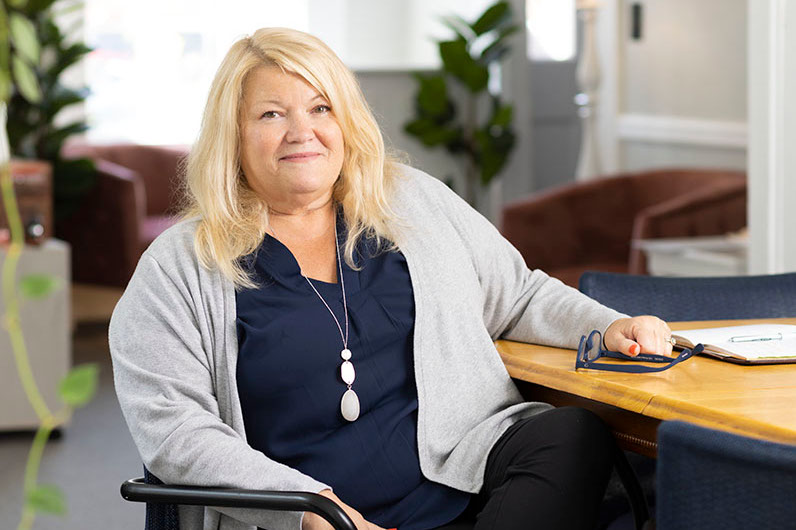In 2002, the most senior advocate at the Women’s Crisis Center in Newburyport put a yellow sticky note on a client’s file that said, “very lethal case.”
Within six weeks, the woman was dead, murdered by her husband, who also killed himself, orphaning their two daughters.
Twenty years ago, domestic violence advocates had very little to go on besides intuition when it came to identifying especially lethal cases, says Suzanne Dubus, CEO of what is now the Jeanne Geiger Crisis Center.
“At that time, that’s the only way we knew to identify really dangerous cases,” she says. And although they threw everything they could at this particularly lethal case—working with the police and the courts, for instance—there were other things that stood in the way of helping her.
“None of us were working together,” Dubus says. “We could talk to each other and say, ‘Hey, we think so-and-so needs some help,’ but we couldn’t really talk about case management. We couldn’t talk about the details of the case because confidentiality laws had us all running scared, and so we just kind of thought we couldn’t do that.”
After that woman was killed, though, they knew they needed things to change: There were gaps in the system that “allowed offenders to walk through them.”
“What was going to be different the next time someone came through our doors who was in just as much danger? What are we going to do differently so that we can we change the system so that we’ll have a better approach?” Dubus says.
Today things are different. Rather than relying on a sixth sense or intuition, the Jeanne Geiger Crisis Center developed two assessments for identifying the most high-risk cases: The Domestic Violence High Risk Team (DVHRT) Model and the Danger Assessment for Law Enforcement (DA-LE).
The model has proven to be successful.
“Since the model was implemented in 2005, in the greater Newburyport area, we’ve had zero homicides in the past 17 years versus eight in the 10 years before,” Dubus says.
Now, the Jeanne Geiger Crisis Center is spreading that model and tools across the country with the launch of the Geiger Institute, a national initiative to end domestic violence homicides. The Geiger Institute aims to partner with communities around the country, including law enforcement, domestic violence advocacy organizations, and prosecutors, to offer its violence assessment tools and resources, along with training and technical assistance.
“We are going into different communities, we’re training them on the research about dangerous domestic violence cases, and we’re helping them to identify the risk factors that are in place before a woman is killed so that we can better predict and identify who those women are,” Dubus says, adding that she says “women” because they are the primary victims of domestic violence homicide.
In fact, current or former intimate partners commit 14 percent of all homicides in the United States, with more than 70 percent of the victims being female, and disproportionately women of color.
At the heart of that research and training are the models that the Jeanne Geiger Crisis Center developed for predicting and identifying domestic violence homicide before it happens.
The DVHRT Model is effective because many domestic violence homicides are very predictable—risk factors include things like extreme and constant jealousy, forced sex, prior strangulation, unemployment, and access to firearms—and because of that predictability, research-based risk assessments like the DVHRT Model can help a community’s domestic violence response system identify the most dangerous cases.
The Department of Justice’s Office on Violence Against Women recognized the DVHRT Model as a “leading promising practice” in intimate partner homicide reduction.
The other tool, DA-LE, is an 11-question, evidence-based risk assessment tool that identifies victims at the highest risk of intimate partner homicide or near-lethal assault and is designed to be easily administered by responding law enforcement officers. It helps them recognize whether a domestic violence 9-1-1 call is part of a larger pattern of increasing violence that needs a different level of intervention.
“We want law enforcement to have a sense of the context of the domestic violence, what the history of domestic violence has been in that family,” Dubus says.
The Jeanne Geiger Crisis Center has already provided training and technical assistance to more than 250 jurisdictions across the country. Now, with the launch of the Geiger Institute, that nationwide training will be more formalized and widespread, with plans to grow its staff, develop new partnerships, raise funding, and evolve the work to increase safety for marginalized communities.
“Part of what the Geiger Institute is trying to do is raise private investment dollars to build our capacity to do more work with more communities, so that we’re not working one community at a time, but rather we’re able to answer the demand,” Dubus says.
These models also help drive home the sense of urgency: Some cases are emergencies.
“There are going to be times, there are going to be some survivors, that walk through that door who require immediate hands-on [help],” Dubus says. “There can be no waiting list.”
Contact jeannegeigercrisiscenter.org

